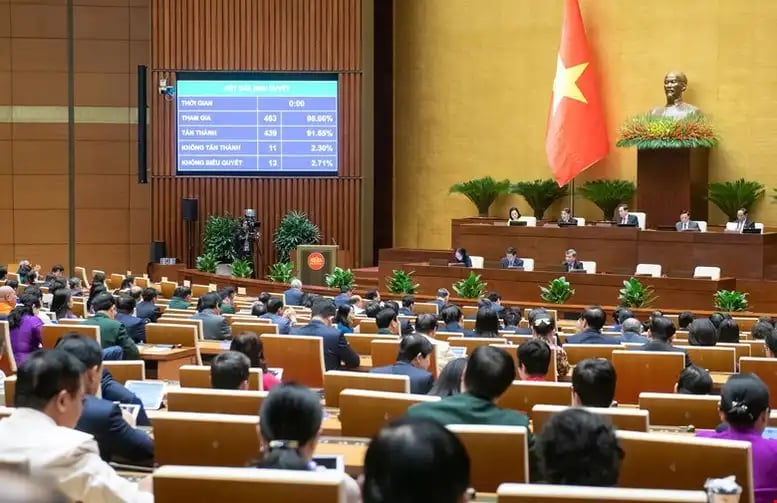REVISED ELECTRICITY LAW: LEGAL FRAMEWORK FOR SUSTAINABLE ENERGY DEVELOPMENT IN VIETNAM
The Revised Electricity Law 2024 establishes a legal framework to promote renewable energy, ensure national energy security, and support sustainable economic development. Comprising 9 chapters and 81 articles, the law encompasses major policies such as power planning, competitive electricity markets, and the development of new energy sources.
GENERAL INFORMATIONMARKET
VIETNGA ENERGY
12/3/20244 min read


Chairman of the National Assembly's Committee on Science, Technology, and Environment Le Quang Huy presents the report on explanation, reception, and revision of the draft revised Electricity Law.
On November 30, 2024, during the 8th session of the 15th National Assembly, the Revised Electricity Law was officially passed with a high approval rate of 91.65% (439/463 delegates). This law is expected to create a significant breakthrough in Vietnam's energy development sector, ensuring national energy security, promoting energy transition, and meeting the growing demand for electricity.
SIGNIFICANCE OF THE REVISED ELECTRICITY LAW:
The Revised Electricity Law replaces the 2004 Electricity Law (amended multiple times) and officially takes effect on February 1, 2025. This marks a critical step in concretizing the major orientations outlined in Resolution No. 55-NQ/TW on the National Energy Development Strategy. It also aims to achieve net-zero emissions by 2050, a commitment Vietnam made at COP26.
In the context of the Fourth Industrial Revolution and the global green energy transition, the Revised Electricity Law serves as a legal tool to remove barriers and attract investment in renewable energy projects such as solar power, offshore wind power, hydrogen, and nuclear energy.
HIGHLIGHTS OF THE REVISED ELECTRICITY LAW:
1. Power Planning and Development Investment:
The law emphasizes specific requirements for National Power Development Planning with clear decentralization between central and local levels. New mechanisms include:
Adding regulations on bidding to select investors for power source projects.
Establishing special mechanisms for emergency power projects to ensure energy supply security during shortages.
2. Development of Renewable Energy and New Energy:
The law provides detailed regulations on renewable energy development, focusing on:
Offshore Wind Power: Projects categorized into nearshore and offshore, maximizing Vietnam's marine potential.
Hydrogen and Nuclear Power: Dedicated chapters to foster research and development in new energy sources.
Additionally, self-generation and self-consumption mechanisms for renewable energy projects are prioritized to align with global trends.
3. Roadmap to Eliminate Cross-Subsidy in Electricity Pricing:
A crucial aspect is the gradual reduction and eventual elimination of cross-subsidization in electricity prices among customer groups and regions. This ensures transparency and fairness in the electricity market, with prices reflecting actual production and distribution costs.
4. Improving Electricity Market Operations:
The law introduces new regulations for:
Direct power purchase agreements between power generators and major customers.
Futures electricity markets, aligning with international integration trends.
5. Enhancing Electrical Safety and Environmental Protection:
The new provisions focus on:
Protecting power infrastructure and the safety of hydropower reservoirs.
Applying high technical standards to ensure the safety of citizens and the environment.
DETAILED STRUCTURE OF THE REVISED ELECTRICITY LAW:
The law is structured into 9 chapters and 81 articles, covering areas from planning and power development to environmental protection. Key chapters include:
Chapter I: General Provisions (8 Articles): Main Content: (i) State policies on power development aimed at environmental protection, energy transition, and achieving net-zero emissions by 2050. (ii) Institutionalizing Party and State policies on electricity pricing, including mechanisms for electricity pricing for customer groups and charging stations for green transportation. Policies for electricity development in rural, mountainous, border, island areas, and regions with socio-economic challenges. (iii) Adding definitions for concepts related to electricity activities.
Chapter II: Power Development Planning and Project Investment (4 Sections, 22 Articles): Main Content: (i) Specific requirements for National Power Development Planning and provincial power grid development; (ii) New mechanisms for bidding in power source projects, tracking project progress, and handling delayed projects; (iii) Regulations for emergency power project investments to ensure energy supply security.
Chapter III: Renewable and New Energy Development (2 Sections, 16 Articles): Institutionalizing Party directives and government resolutions on renewable and new energy, particularly self-generation, self-consumption, offshore wind power, nuclear energy, and hydrogen.
Chapter IV: Electricity Operation Licenses (13 Articles): Detailed provisions on the issuance and revocation of electricity operation licenses for power generation, transmission, distribution, wholesale, and retail activities at both central and local levels.
Chapter V: Electricity Trading Activities (3 Sections, 29 Articles): Key Revisions: (i) Electricity futures contracts; (ii) Direct power purchase agreements between large electricity users and generators; (iii) Rights and obligations of entities in the competitive electricity market; (iv) Pricing for electricity and related services in competitive markets.
Chapter VI: National Power System Operation and Dispatch (13 Articles): Revisions on the operation and dispatch of the national power system, interconnection with foreign power grids, and electricity demand management.
Chapter VII: Power Infrastructure Protection and Electrical Safety (3 Sections, 22 Articles): Key Provisions: (i) Protection of power generation facilities; (ii) Technical safety inspection of electrical equipment; (iii) General electrical safety requirements (6 Articles) on safety in hydropower, addressing gaps in the current Water Resources Law.
Chapter VIII: State Management Responsibilities in the Electricity Sector (4 Articles): Clearly defined responsibilities and transparency principles for state management in electricity.
Chapter IX: Implementation Provisions (3 Articles): Includes a transitional clause to ensure consistent application of the law without legal gaps.
BENEFITS OF THE REVISED ELECTRICITY LAW:
Promoting Renewable Energy: Strong legal support mechanisms for solar power, wind power, and new energy sources.
Ensuring Energy Security: Addressing growing electricity demand and mitigating future shortages.
Attracting Investment: Transparent bidding mechanisms and regulations create opportunities for major domestic and international investors.
Environmental Protection: Aligning power development with global emission reduction goals.
CONCLUSION:
The Revised Electricity Law is a significant milestone in Vietnam's energy development strategy, laying the foundation for sustainable growth and global integration. It also reaffirms Vietnam's commitment to environmental protection and green energy transition.
With this new law, businesses and investors in the energy sector have a tremendous opportunity to contribute to the country's economic growth and environmental preservation.
- According to the baochinhphu
VIETNGA ENERGY
Savings – Efficiency – Sustainability


Quốc hội biểu quyết thông qua Luật Điện lực (sửa đổi)
HEAD OFFICE
Address | No. 3, Street 10, Quarter 4, An Khanh Ward, Thu Duc City, Ho Chi Minh City, Vietnam.
Phone | (+84) 286 2872 067
Email | info@nangluongvietnga.com
REPRESENTATIVE OFFICE
Address | Floor 5, IC Building, No. 82 Duy Tan Street, Dich Vong Hau Ward, Cau Giay District, Hanoi, Vietnam.
VIET NGA SUSTAINABLE ENERGY CO., LTD
BUSINESS SUPPORT
Phone | (+84) 937 669 985
Email | hoangsen@nangluongvietnga.com
Phone | (+84) 964 819 199
Email | thuynv@nangluongvietnga.com
TECHNICAL SUPPORT
Phone | (+84) 902 968 481
Email | chinhnv@nangluongvietnga.com
Phone | (+84)96 481 9199
Email | thuynv@nangluongvietnga.com
------------------------------------------------------------------------
CONFIDENTIAL & PROPRIETARY
Copyright by VIETNGA ENERGY | 2024 All Rights Reserved Design by Cre-tive Network


